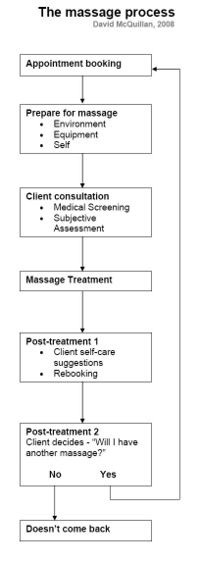Client Consultation
Contents
Client Consultation
The client consultation is an extremely important element of the massage process. It is at this time that you determine what the client wants, what their medical history is, and how you are going to perform their massage.
- Read
- Fritz, 2004 - Informed Consent (p. 43 – 46) then p. 263 – 266.
- Salvo, 2007 - Informed Consent (p. 199 - 200)
Hopefully this has made it clear to you why it's important to gain informed consent for everything you do with your client, and what informed consent means.
Medical Screening
You should always begin your client consultation with a medical screening process. This is very important! Failing to medically screen your client could lead to medical complications. In the Otago Polytechnic massage therapy clinics, we use a Client Details form for this purpose.
When working with a new client you need to review the form that they have completed, and clarify anything which is unclear. When working with a repeat client you need to review the form before beginning treatment, and it's a good idea to ask regularly whether anything has changed.
Subjective Assessment
After completing the medical screening process, we typically progress to assessment of the client's situation using subjective and objective assessment techniques. As you progress through the course, you will be introduced to a range of assessment strategies that are applied in the client consultation process, but at this stage you mostly need to ensure that you know why the client has come to you.
This might seem obvious, but it is surprising how often students and even healthcare professionals forget this, and head off on a pathway of assumed client need.
Client Orientation
It's advisable to have an orientation process that you take new clients through so that they are aware of your clinical processes. This process should be comprehensive enough so that your client feels comfortable in the new environment, but should not impinge overly on their massage session.
Fritz (2004) provides a list of things which she considers must be part of this orientation
- Take the client to the massage area
- Show him/her where they may hang their clothes.
- Provide instructions about undressing - where to put clothes, how much clothing you need them to remove and leave on.
- Demonstrate the massage table/chair/mat, how it is draped, how the draping works and the position you would like them to adopt on the table
- Ask about the use of music and offer a few selections
- Show the client where the toilet is
- Briefly explain any charts you might have on the walls
- Ask if the client has any preference in terms of lubricant, and let them know the options
- Explain that you will leave the room while they undress (except if they have a mobility impairment, and need your help getting on the table)
- Explain all sanitary precautions
- Show the client the sign on the door stating that a massage is in session
- Give an idea of the massage flow
- Instruct the client how to get onto the table safely and without damaging the table
- Ask if the client has any questions
- Explain that you will be washing your hands and preparing for the massage while you get ready
- Tell the client how long you will be gone and that you will knock before entering the room.
Activities
- Consider this list. Are there any things you would remove or add to the list?
- Create a checklist of things which you feel you need to tell a new client, and practice using it over the next month.
